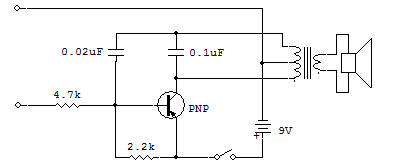

Rain Detector

One way to tell if it's raining is to stand outside without an umbrella... if you get wet, it's raining! Fortunately, there is a better way, our rain detector circuit.
After you finish the wiring for this Project, carefully place the exposed ends of the two long wires side-by-side on a piece of plastic or wood. Place the two exposed ends as close as you can without having them touch. Use tape to hold the two long wires in place (make, sure their exposed ends don't touch and that the exposed ends aren't covered by the tape).
Using this Project is a snap. Just turn power ON and place the two long wires wherever you want to detect rain or water. When water falls on the ends of the long wires, you'll hear a sound from the Speaker.
You can use this Project for more than just detecting rain, of course. You can use it to check if a faucet is dripping, or if the water in the bathtub or aquarium is getting too high.
This Project works because water can conduct electricity Just like a wire. When we say something can "conduct" electricity, we mean electricity can flow through it. When water Fails on the exposed ends of the two long wires, it "completes" the circuit and you hear a sound from the Speaker.
But water doesn't conduct electricity as well as a wire, which is why we have the exposed ends so close together. But does all water conduct alike?
Try this, remove the two long wires from the wood or plastic you taped them to. Get two glasses of water. In one glass dissolve as many spoons of salt as you can. In the fresh water glass place the exposed ends of the two long wires as far apart as you can. Move one long wire toward the other. Note when you hear a sound from the Speaker.
Now try the same thing with the glass of salt water. In which one did the detector sound with the wires farthest apart?
That's the glass with the water that conducts electricity best!
